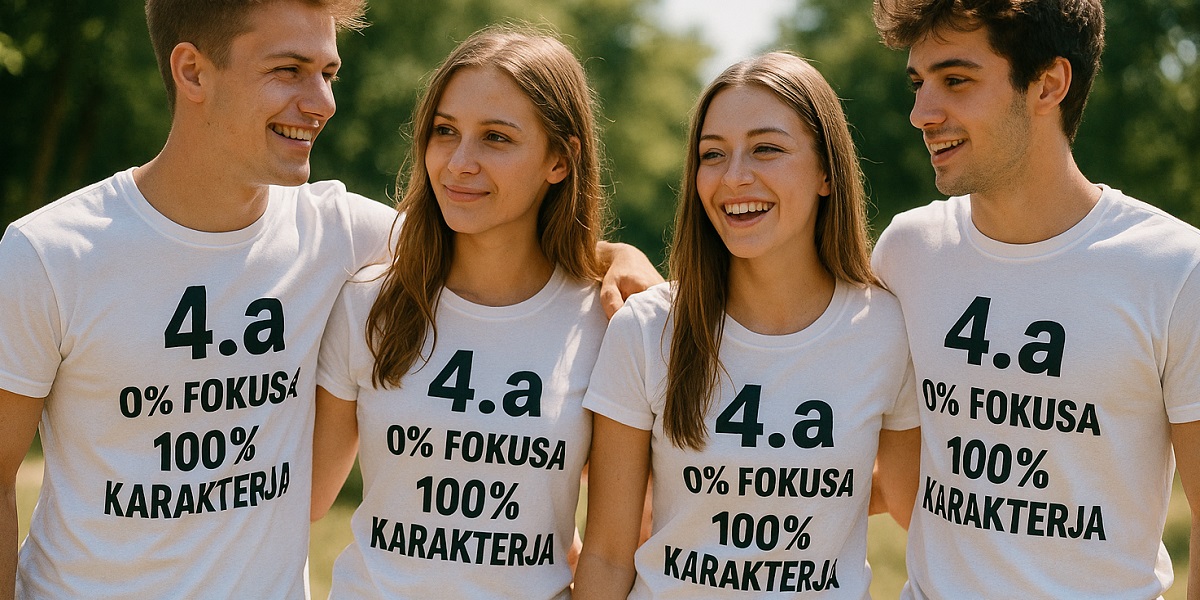
Graduation Shirts – How to Choose a Design Students Will Actually Wear?
Published: May 7, 2025Graduation shirts have long become more than just a school keepsake. They’ve turned into symbols of community, humor, and style that follow students long after the final school bell. That’s why it’s important they’re not just an “obligatory purchase” but something students actually enjoy wearing – proudly, often, and with a smile. In this article, we’ll reveal what makes a shirt become a favorite rather than end up at the bottom of a drawer.
Include Students from the Start
The biggest mistake when ordering graduation shirts is having one person or a teacher choose the design without consulting the class. The result is often a design that excites no one. If you want students to wear the shirt happily, involve them from the very beginning.
- Voting on shirt color or fabric type (cotton, blend, oversized fit).
- Collecting ideas for phrases or humorous slogans relevant to the generation.
- Collaborative creation of a logo or emblem with symbols meaningful to the class.
When students help create the design, they form an emotional connection to the product. That’s what makes them wear the shirt not just on graduation day but also during summer trips – even years later, out of nostalgia.
Less Is More: Modern Design over “Info Overload”
While it’s tempting to include everything – names, year, school logo, slogan, sponsors – the result is often a visually overloaded shirt no one wants to wear casually. Today’s students value simplicity and aesthetics, much like the clothes they buy at retail stores.
- Use one or two graphic elements and leave space to breathe.
- Avoid too many bright colors unless it’s well-planned.
- Choose a modern font and follow youth trends (e.g., retro, minimalist, Y2K aesthetic).
The shirt should be something someone would wear even without the school context. The more it resembles trendy streetwear, the more wearable it is – and the more memorable it becomes.
Add a Personal Touch: Names, Nicknames, or Inside Jokes
A graduation shirt becomes even more special when it includes something unique to the class – something only they understand, but that holds great meaning. This personalization creates strong emotional value and ensures the shirt becomes a true keepsake.
- Add names or nicknames on the back of the shirt (if budget allows).
- A slogan based on an inside joke, class phrase, or popular teacher’s quote.
- Arrange names in the shape of a heart, number, or symbol.
Personalized shirts aren’t just gifts – they’re proof of belonging. And that feeling of connection determines whether the shirt is “just another school formality” or something proudly worn on a graduation trip, at the beach, or on social media.
Quality Matters: Better One Good Shirt Than Two Bad Ones
Not all shirts are created equal. A thin, uncomfortable, or quickly faded shirt might be cheaper – but likely won’t be worn much, and the impression it leaves will reflect that. That’s why it pays to invest in quality fabric and durable printing.
- Choose soft, comfortable materials like 100% cotton or high-quality blends with polyester.
- Use durable printing methods like screen printing or embroidery that withstand many washes.
- Check the fit – oversized, fitted, or unisex – and consult students on their preferences.
A good shirt gets worn. A bad one is forgotten. If you want your brand or school to stay present even after graduation, quality is key.
A Shirt That Becomes a Memory
Graduation shirts aren’t just fabric – they’re symbols of a closing chapter, friendships, inside jokes, and shared experiences. If they’re well-designed, comfortable, and personally meaningful, they won’t end up in a closet – they’ll become part of daily life even after diplomas are tucked away.
By involving students, embracing modern design, adding personalization, and focusing on quality, you can create a shirt that’s truly wearable. More importantly – it will carry a piece of your school’s, class’s, or company’s story that made it possible.












































 Slovenski
Slovenski




